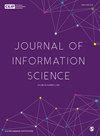利用长短期记忆网络识别公式蕴涵
IF 1.7
4区 管理学
Q3 COMPUTER SCIENCE, INFORMATION SYSTEMS
引用次数: 0
摘要
本文提出了一种识别公式蕴涵的方法,它涉及到寻找数学公式对之间的蕴涵关系。由于目前的公式相似度检测方法无法解释数学公式对之间更广泛的关系,因此识别公式蕴涵变得至关重要。为此,实现了一种长短期记忆(LSTM)神经网络,利用逐符号注意来识别公式蕴涵。然而,由于缺乏相关的训练和验证语料库,第一步也是最重要的一步是以自动化的方式创建一个足够大的符号级mathenthada数据集。根据相应符号嵌入之间的相似程度,math限定数据集中的符号对被分配为“蕴涵”或“中性”标签。一种改进的符号到向量(isymbol2vec)方法使用维基百科的科学文档语料库和连续词袋(CBOW)架构生成数学符号(在LATEX中)及其嵌入。最后,使用math限定数据集训练和验证的LSTM网络预测了测试公式对的公式蕴涵,合理的准确率为62.2%。本文章由计算机程序翻译,如有差异,请以英文原文为准。
Recognising formula entailment using long short-term memory network
The article presents an approach to recognise formula entailment, which concerns finding entailment relationships between pairs of math formulae. As the current formula-similarity-detection approaches fail to account for broader relationships between pairs of math formulae, recognising formula entailment becomes paramount. To this end, a long short-term memory (LSTM) neural network using symbol-by-symbol attention for recognising formula entailment is implemented. However, owing to the unavailability of relevant training and validation corpora, the first and foremost step is to create a sufficiently large-sized symbol-level MATHENTAIL data set in an automated fashion. Depending on the extent of similarity between the corresponding symbol embeddings, the symbol pairs in the MATHENTAIL data set are assigned ‘entailment’ or ‘neutral’ labels. An improved symbol-to-vector (isymbol2vec) method generates mathematical symbols (in LATEX) and their embeddings using the Wikipedia corpus of scientific documents and Continuous Bag of Words (CBOW) architecture. Eventually, the LSTM network, trained and validated using the MATHENTAIL data set, predicts formulae entailment for test formulae pairs with a reasonable accuracy of 62.2%.
求助全文
通过发布文献求助,成功后即可免费获取论文全文。
去求助
来源期刊

Journal of Information Science
工程技术-计算机:信息系统
CiteScore
6.80
自引率
8.30%
发文量
121
审稿时长
4 months
期刊介绍:
The Journal of Information Science is a peer-reviewed international journal of high repute covering topics of interest to all those researching and working in the sciences of information and knowledge management. The Editors welcome material on any aspect of information science theory, policy, application or practice that will advance thinking in the field.
 求助内容:
求助内容: 应助结果提醒方式:
应助结果提醒方式:


